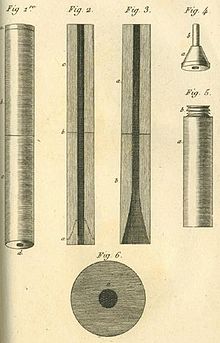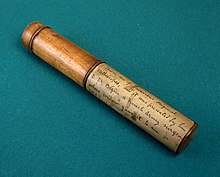René Laennec
René Laennec | |
|---|---|
Quimper, France | |
| Died | 13 August 1826 (aged 45) |
| Alma mater | University of Paris |
| Known for | Inventing the stethoscope |
| Spouse | Jacquette Guichard (1824-1826) |
René-Théophile-Hyacinthe Laennec conditions. He became a lecturer at the Collège de France in 1822 and professor of medicine in 1823. His final appointments were that of head of the medical clinic at the Hôpital de la Charité and professor at the Collège de France. He went into a coma and subsequently died of tuberculosis on August 13, 1826 at age 45. [2]
Early life
Laennec was born in
His father (a lawyer) later discouraged him from continuing as a doctor and René then had a period of time where he took long walks in the country, danced, studied Greek, and wrote poetry. However, in 1799 he returned to study. Laennec studied medicine at the
Invention of the stethoscope
René Laennec wrote in the classic treatise De l'Auscultation Médiate,[6]
In 1816, [he was] consulted by a young woman laboring under general symptoms of diseased heart, and in whose case percussion and the application of the hand were of little avail on account of the great degree of fatness. The other method just mentioned direct auscultation being rendered inadmissible by the age and sex of the patient, I happened to recollect a simple and well-known fact in acoustics, ... the great distinctness with which we hear the scratch of a pin at one end of a piece of wood on applying our ear to the other. Immediately, on this suggestion, I rolled a quire of paper into a kind of cylinder and applied one end of it to the region of the heart and the other to my ear, and was not a little surprised and pleased to find that I could thereby perceive the action of the heart in a manner much more clear and distinct than I had ever been able to do by the immediate application of my ear.
Laennec had discovered that the new stethoscope was superior to the normally used method of placing the ear over the chest, particularly if the patient was overweight. A stethoscope also avoided the embarrassment of placing the ear against the chest of a woman.[4]


Laennec is said to have seen school children playing with a long piece of solid wood in the days leading up to his innovation.[7] The children held their ear to one end of the stick while the opposite end was scratched with a pin, the stick transmitted and amplified the scratch. His skill as a flautist may also have inspired him. He built his first instrument as a 25 cm by 2.5 cm hollow wooden cylinder, which he later refined into three detachable parts. The refined design featured a funnel-shaped cavity to augment the sound, separable from the body of the stethoscope.[8]
His clinical work allowed him to follow chest patients from bedside to the autopsy table. He was therefore able to correlate sounds captured by his new instruments with specific pathological changes in the chest, in effect pioneering a new non-invasive diagnostic tool.
Laennec coined the phrase mediate

The stethoscope quickly gained popularity as De l'Auscultation Médiate
Laennec often referred to the stethoscope as "the cylinder", and as he neared death only a few years later, he bequeathed his own stethoscope to his nephew, referring to it as "the greatest legacy of my life".
The modern
Other medical contributions

He developed the understanding of peritonitis and cirrhosis. Although the disease of cirrhosis was known, Laennec gave cirrhosis its name, using the Greek word (κιρρος kirrhos, tawny) that referred to the tawny, yellow nodules characteristic of the disease.
He coined the term
He also studied
Laennec advocated objective scientific observation. Professor
Religious views

Laennec "was intensely religious and was a devout Catholic all his life".
In
Laennec was a man of the greatest probity, habitually observant of his religious and social duties. He was a sincere Christian, and a good Catholic, adhering to his religion and his church through good report and bad report." His death (says M. Bayle) was that of a Christian. Supported by the hope of a better life, prepared by the constant practice of virtue, he saw his end approach with much composure and resignation. His religious principles, imbibed with his earliest knowledge, were strengthened by the conviction of his maturer reason. He took no pains to conceal them when they were disadvantageous to his worldly interests; and he made no boast of them, when their avowal might have been a title to favour and advancement."
—J. Forbes (1838 [1835])[10]
Legacy and tribute
Honors: Medical terms named after Laennec:
- Laennec's cirrhosisrefers to the appearance of regenerated liver, comprising small lobules separated by a fine, fibrous tissue;
- Laennec's thrombus is an antenatal thrombus in the heart;
- Laennec's pearls refer to sputum produced by asthmatics;
- Hamman's murmur, also known as Laënnec–Hamman symptom, Laënnec–Müller–von Bergmann–Hamman symptom, or Hamman's crunch, is a crunching sound due to spontaneous mediastinal emphysema, heard over the precordium.
- At the Université Claude Bernard Lyon 1 one of the four medical schools is named after Laennec.
- On 17 February 2016, Google celebrated his 235th birthday with a Google Doodle.[14]
Laennec in fiction
A Rene Laennec appears in Rudyard Kipling's Rewards and Fairies, the second of two books where two children, Dan and Una, encounter past inhabitants of England. In the short section "Marlake Witches", set during the Napoleonic Wars, Una meets a consumptive young lady who speaks of being treated by a French doctor, a prisoner on parole, one Rene Laennec. This prisoner discusses with a local herbalist the use of 'wooden trumpets' for listening to patients' chests, much to the distrust of the local doctor. Obviously, Kipling was aware of Laennec's work and invented an English connection.
He was the subject of a 1949 French film Doctor Laennec in which he was played by Pierre Blanchar.
Laennec's landmarks in Paris
On the exterior wall of the "
-
The entrance in Rue de Sèvres
-
Laennec's memorial tablet
-
One of the old buildings of the hospital
-
De l'auscultation médiate ... Paris: J.-A. Brosson et J.-S. Chaude, 1819.
-
De l'auscultation médiate .... Drawings of the stethoscope and lungs.
-
De l'auscultation médiate ... Most of the plates in his book illustrate the diseased lung as do these four images that are consistent with lungs affected by tuberculosis.
Footnotes
- Bretonnames, and Laennec himself did not use the diaraesis in his signature.
References
- PMID 25140689. Retrieved 5 September 2019.)
{{cite journal}}: CS1 maint: multiple names: authors list (link - ISBN 9780813512242.
- ISBN 9781851096930.
- ^ PMID 17048358.
- PMID 2504361.
- ^ a b c d Laennec, René T.H. (1819). De l'Auscultation Médiate, ou Traité du Diagnostic des Maladies des Poumon et du Coeur [On Indirect Listening: A treatise on the diagnosis of lung and heart diseases]. Paris, FR: Brosson & Chaudé. 8. Two volumes.
- ^ a b c
Scherer, John R. (2007). "Before cardiac MRI: Rene Laennec (1781–1826) and the invention of the stethoscope". PMID 18651515.
- ISBN 978-0-19-505523-8– via Internet Archive (archive.org).
- ^ ISBN 978-052127205-6.
- ^ Forbes, J.(ed.). A Treatise on the Diseases of the Chest and on Mediate Auscultation. New York / Philadelphia: Samuel Wood & Sons / Desilver, Thomas & Co. p. xxvii – via Google Books.
- ^ Forbes, John(ed.). A Treatise on the Disease[s] of the Chest. New York: Hafner Publishing Company.
- ^ Bloch, Harry (1993). "Dr. Connor's technique". Family Practice.
- ^ a b c "Laennec, Renee-Theophile-Hyacinthe". Catholic Encyclopedia. Retrieved 18 August 2014.
- ^ "Rene Laennec's 235th birthday". Google. 17 February 2016.
Further reading
- Bon, H. (1925). Laennec (1781–1826). Dijon, FR: Lumière.
- Duffin, Jacalyn (1998). To See with a Better Eye: The life of R.T.H. Laennec. Princeton, NJ: Princeton University Press.
- Laennec, R.T.H. (1819). De l'Auscultation Médiate ou Traité du Diagnostic des Maladies des Poumons et du Coeur. Paris, FR: Brosson & Chaudé. — The complete title of this book, often referred to as the 'Treatise' is De l'Auscultation Médiate ou Traité du Diagnostic des Maladies des Poumons et du Coeur (On Mediate Auscultation or Treatise on the Diagnosis of the Diseases of the Lungs and Heart).
- Laennec, R.T.H. (1819). De l'Auscultation Médiate ... (online and analyzed ed.) – via BibNum.Education.FR. – [click 'à télécharger' for the English version].
- Rouxeaux, U. (1920) [1912]. Laennec. Paris, FR: Baillière.






